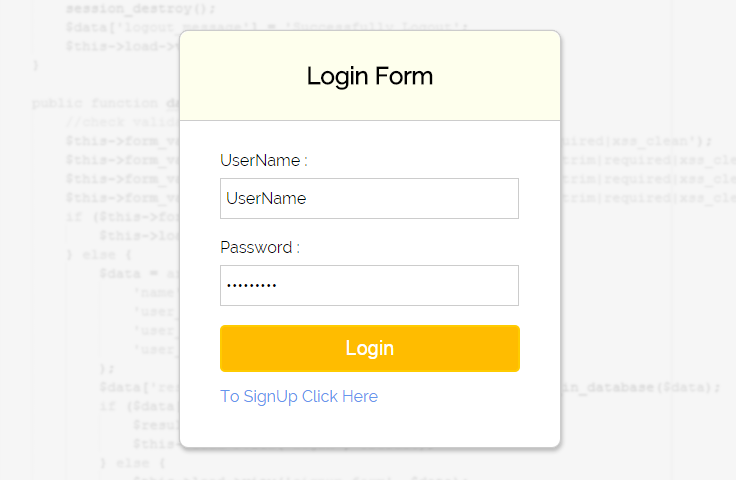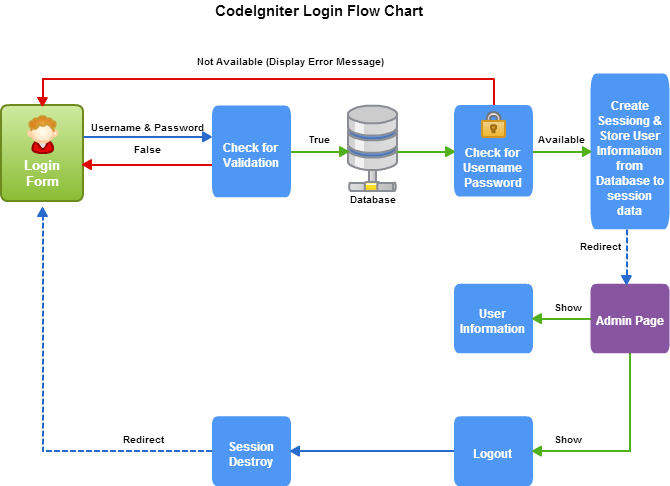CodeIgniter Simple Login Form With Sessions
In this tutorial, we are going to learn about creating a simple login form in CodeIgniter. In login form, we made registration module, login module and admin panel using sessions.
We also have a paid ready-to-use advance login & registration module built on CodeIgniter that you can check out at CodeIgniter Login Registration Form.
Creating sessions in CodeIgniter is different from simple PHP. I will give you detailed information about all the method as we move further in this tutorial.
Watch the live demo or download code from the link given below

DOWNLOAD SCRIPT
Note : You can also refer the PHPProjectInstall.pdf file given in the download code folder.
Before starting, let’s have a look on what we are going to learn about.
- Create login page, signup page and admin page.
- Setting up validation to all input field.
- Check for existing users in database during signup process.
- Check for username and password in database and show their information stored in database.
- Create session for admin panel, store users input data in session and destroy session(logout).
We are introducing a flow chart which will give you a clear vision about the objectives of this tutorial.

Firstly, set base URL in config.php file of CodeIgniter as given below:-
$config['base_url'] = 'http://localhost/login/';Tutorial Scripts in detail
Below are the details of the code used in this tutorial with proper explanation.
Database Table: user_login
Now create a database name ‘login‘ with a table ‘user_login‘ using the code given below
create database login;
CREATE TABLE IF NOT EXISTS `user_login` (
`id` int(11) NOT NULL AUTO_INCREMENT,
`user_name` varchar(255) NOT NULL,
`user_email` varchar(255) NOT NULL,
`user_password` varchar(255) NOT NULL,
PRIMARY KEY (`id`)
) Controller: user_authentication.php
Before start coding, let’s load all the libraries required to make and manage login form.
First we need to load session and validation libraries in controller file.
So, let’s start coding with controller. Create a file name ‘user_authentication.php‘ in ‘application/controllers’ folder of CodeIgniter. Write the code given below in the file.
<?php
session_start(); //we need to start session in order to access it through CI
Class User_Authentication extends CI_Controller {
public function __construct() {
parent::__construct();
// Load form helper library
$this->load->helper('form');
// Load form validation library
$this->load->library('form_validation');
// Load session library
$this->load->library('session');
// Load database
$this->load->model('login_database');
}
// Show login page
public function index() {
$this->load->view('login_form');
}
// Show registration page
public function user_registration_show() {
$this->load->view('registration_form');
}
// Validate and store registration data in database
public function new_user_registration() {
// Check validation for user input in SignUp form
$this->form_validation->set_rules('username', 'Username', 'trim|required|xss_clean');
$this->form_validation->set_rules('email_value', 'Email', 'trim|required|xss_clean');
$this->form_validation->set_rules('password', 'Password', 'trim|required|xss_clean');
if ($this->form_validation->run() == FALSE) {
$this->load->view('registration_form');
} else {
$data = array(
'user_name' => $this->input->post('username'),
'user_email' => $this->input->post('email_value'),
'user_password' => $this->input->post('password')
);
$result = $this->login_database->registration_insert($data);
if ($result == TRUE) {
$data['message_display'] = 'Registration Successfully !';
$this->load->view('login_form', $data);
} else {
$data['message_display'] = 'Username already exist!';
$this->load->view('registration_form', $data);
}
}
}
// Check for user login process
public function user_login_process() {
$this->form_validation->set_rules('username', 'Username', 'trim|required|xss_clean');
$this->form_validation->set_rules('password', 'Password', 'trim|required|xss_clean');
if ($this->form_validation->run() == FALSE) {
if(isset($this->session->userdata['logged_in'])){
$this->load->view('admin_page');
}else{
$this->load->view('login_form');
}
} else {
$data = array(
'username' => $this->input->post('username'),
'password' => $this->input->post('password')
);
$result = $this->login_database->login($data);
if ($result == TRUE) {
$username = $this->input->post('username');
$result = $this->login_database->read_user_information($username);
if ($result != false) {
$session_data = array(
'username' => $result[0]->user_name,
'email' => $result[0]->user_email,
);
// Add user data in session
$this->session->set_userdata('logged_in', $session_data);
$this->load->view('admin_page');
}
} else {
$data = array(
'error_message' => 'Invalid Username or Password'
);
$this->load->view('login_form', $data);
}
}
}
// Logout from admin page
public function logout() {
// Removing session data
$sess_array = array(
'username' => ''
);
$this->session->unset_userdata('logged_in', $sess_array);
$data['message_display'] = 'Successfully Logout';
$this->load->view('login_form', $data);
}
}
?>Views: login_form.php
This will show login form on the view page.
<html>
<?php
if (isset($this->session->userdata['logged_in'])) {
header("location: http://localhost/login/index.php/user_authentication/user_login_process");
}
?>
<head>
<title>Login Form</title>
<link rel="stylesheet" type="text/css" href="<?php echo base_url(); ?>css/style.css">
<link href='http://fonts.googleapis.com/css?family=Source+Sans+Pro|Open+Sans+Condensed:300|Raleway' rel='stylesheet' type='text/css'>
</head>
<body>
<?php
if (isset($logout_message)) {
echo "<div class='message'>";
echo $logout_message;
echo "</div>";
}
?>
<?php
if (isset($message_display)) {
echo "<div class='message'>";
echo $message_display;
echo "</div>";
}
?>
<div id="main">
<div id="login">
<h2>Login Form</h2>
<hr/>
<?php echo form_open('user_authentication/user_login_process'); ?>
<?php
echo "<div class='error_msg'>";
if (isset($error_message)) {
echo $error_message;
}
echo validation_errors();
echo "</div>";
?>
<label>UserName :</label>
<input type="text" name="username" id="name" placeholder="username"/><br /><br />
<label>Password :</label>
<input type="password" name="password" id="password" placeholder="**********"/><br/><br />
<input type="submit" value=" Login " name="submit"/><br />
<a href="<?php echo base_url() ?>index.php/user_authentication/user_registration_show">To SignUp Click Here</a>
<?php echo form_close(); ?>
</div>
</div>
</body>
</html>Views: registration_form.php
This file will load to show signup form.
<html>
<?php
if (isset($this->session->userdata['logged_in'])) {
header("location: http://localhost/login/index.php/user_authentication/user_login_process");
}
?>
<head>
<title>Registration Form</title>
<link rel="stylesheet" type="text/css" href="<?php echo base_url(); ?>css/style.css">
<link href='http://fonts.googleapis.com/css?family=Source+Sans+Pro|Open+Sans+Condensed:300|Raleway' rel='stylesheet' type='text/css'>
</head>
<body>
<div id="main">
<div id="login">
<h2>Registration Form</h2>
<hr/>
<?php
echo "<div class='error_msg'>";
echo validation_errors();
echo "</div>";
echo form_open('user_authentication/new_user_registration');
echo form_label('Create Username : ');
echo"<br/>";
echo form_input('username');
echo "<div class='error_msg'>";
if (isset($message_display)) {
echo $message_display;
}
echo "</div>";
echo"<br/>";
echo form_label('Email : ');
echo"<br/>";
$data = array(
'type' => 'email',
'name' => 'email_value'
);
echo form_input($data);
echo"<br/>";
echo"<br/>";
echo form_label('Password : ');
echo"<br/>";
echo form_password('password');
echo"<br/>";
echo"<br/>";
echo form_submit('submit', 'Sign Up');
echo form_close();
?>
<a href="<?php echo base_url() ?> ">For Login Click Here</a>
</div>
</div>
</body>
</html>Views: admin_page.php
This file load in the admin part, once user is successfully login to admin page.
<html>
<?php
if (isset($this->session->userdata['logged_in'])) {
$username = ($this->session->userdata['logged_in']['username']);
$email = ($this->session->userdata['logged_in']['email']);
} else {
header("location: login");
}
?>
<head>
<title>Admin Page</title>
<link rel="stylesheet" type="text/css" href="<?php echo base_url(); ?>css/style.css">
<link href='http://fonts.googleapis.com/css?family=Source+Sans+Pro|Open+Sans+Condensed:300|Raleway' rel='stylesheet' type='text/css'>
</head>
<body>
<div id="profile">
<?php
echo "Hello <b id='welcome'><i>" . $username . "</i> !</b>";
echo "<br/>";
echo "<br/>";
echo "Welcome to Admin Page";
echo "<br/>";
echo "<br/>";
echo "Your Username is " . $username;
echo "<br/>";
echo "Your Email is " . $email;
echo "<br/>";
?>
<b id="logout"><a href="logout">Logout</a></b>
</div>
<br/>
</body>
</html>
Models : login_database.php
When a new user register.It check for duplicate user registration.
<?php
Class Login_Database extends CI_Model {
// Insert registration data in database
public function registration_insert($data) {
// Query to check whether username already exist or not
$condition = "user_name =" . "'" . $data['user_name'] . "'";
$this->db->select('*');
$this->db->from('user_login');
$this->db->where($condition);
$this->db->limit(1);
$query = $this->db->get();
if ($query->num_rows() == 0) {
// Query to insert data in database
$this->db->insert('user_login', $data);
if ($this->db->affected_rows() > 0) {
return true;
}
} else {
return false;
}
}
// Read data using username and password
public function login($data) {
$condition = "user_name =" . "'" . $data['username'] . "' AND " . "user_password =" . "'" . $data['password'] . "'";
$this->db->select('*');
$this->db->from('user_login');
$this->db->where($condition);
$this->db->limit(1);
$query = $this->db->get();
if ($query->num_rows() == 1) {
return true;
} else {
return false;
}
}
// Read data from database to show data in admin page
public function read_user_information($username) {
$condition = "user_name =" . "'" . $username . "'";
$this->db->select('*');
$this->db->from('user_login');
$this->db->where($condition);
$this->db->limit(1);
$query = $this->db->get();
if ($query->num_rows() == 1) {
return $query->result();
} else {
return false;
}
}
}
?>CSS : style.css
Design for login, admin and registration page.
#main{
width:960px;
margin:50px auto;
font-family:raleway;
}
span{
color:red;
}
h2{
background-color: #FEFFED;
text-align:center;
border-radius: 10px 10px 0 0;
margin: -10px -40px;
padding: 30px;
}
#login{
width:300px;
float: left;
border-radius: 10px;
font-family:raleway;
border: 2px solid #ccc;
padding: 10px 40px 25px;
margin-top: 70px;
}
input[type=text],input[type=password], input[type=email]{
width:99.5%;
padding: 10px;
margin-top: 8px;
border: 1px solid #ccc;
padding-left: 5px;
font-size: 16px;
font-family:raleway;
}
input[type=submit]{
width: 100%;
background-color:#FFBC00;
color: white;
border: 2px solid #FFCB00;
padding: 10px;
font-size:20px;
cursor:pointer;
border-radius: 5px;
margin-bottom: 15px;
}
#profile{
padding:50px;
border:1px dashed grey;
font-size:20px;
background-color:#DCE6F7;
}
#logout{
float:right;
padding:5px;
border:dashed 1px gray;
margin-top: -168px;
}
a{
text-decoration:none;
color: cornflowerblue;
}
i{
color: cornflowerblue;
}
.error_msg{
color:red;
font-size: 16px;
}
.message{
position: absolute;
font-weight: bold;
font-size: 28px;
color: #6495ED;
left: 262px;
width: 500px;
text-align: center;
}Process
First of all it is needed to type the given below URL in browser.
http://localhost/login/When browser get the above url it will display a login page. This page contains a login section and a signup link.
The whole process includes :-
- SignUp process and
- SignIn process
So, let’s learn about these processes.
Sign Up Process:
When you click on singup link, it will redirect you to ‘SignUp.php’ and display a signup form.
After filling all input field when you click on submit button, all data travels to new_user_registration() function of controller. This function first check validation for each field.
If your data is empty or invalid then it will generate an error message but, if all input field get proper data then it will connect you to database.
Before inserting data to database, it first check for username in database.
If given username is already available in database, a ‘username already exits ! ‘ message will be displayed but if username is not available in database then it will insert all the information in the database and display a ‘SignUp Successfullly !’ message.
Sign In Process:
After signup, you can login by giving a valid username and password. If invalid username or password will be given then a error message will be displayed.
Now let’s have a look at the whole procedure of SignIn. When you enters username and password, the values are travelled to user_login_process() function in controller where the validation for each field is checked.
When all input given are valid then user_login_process() function matches the given username and password with data stored in database.
If match doesn’t found then you will be redirected to login page and an error message will be displayed. But, if match found in database then session will be created and user data will be inserted into session data.
Now, these data are send to admin page where all information along with logout option will be displayed. When you will click on logout then logout() function will be called and where session data will be destroyed. After this, you will be redirect to login page for a new login.
Conclusion :
Thanks for reading the complete post. Hope you have enjoyed reading this blog post and got the concept. You can share your views in the space provided below and get in touch with us.


0 comments:
Post a Comment
Thanks